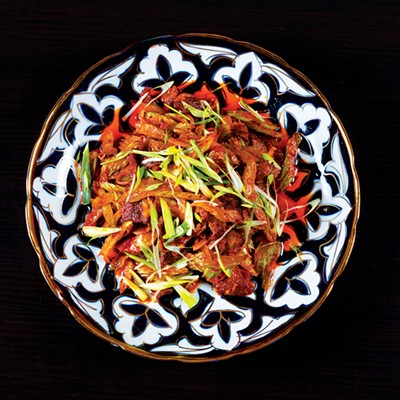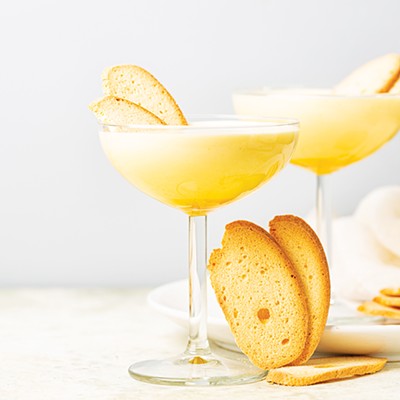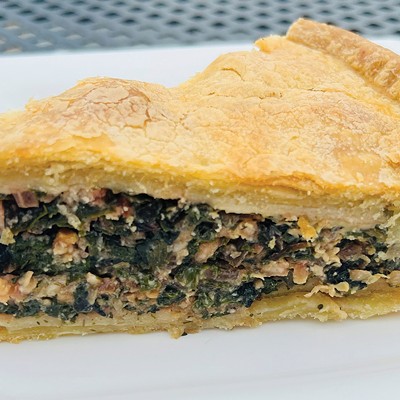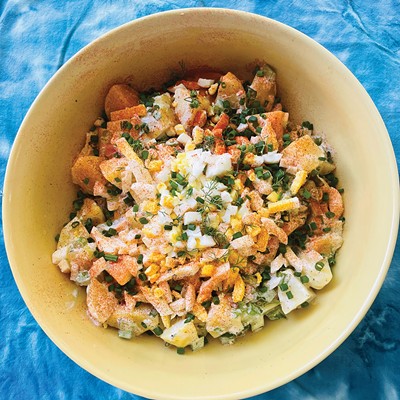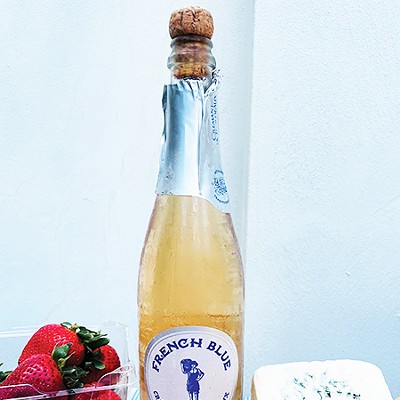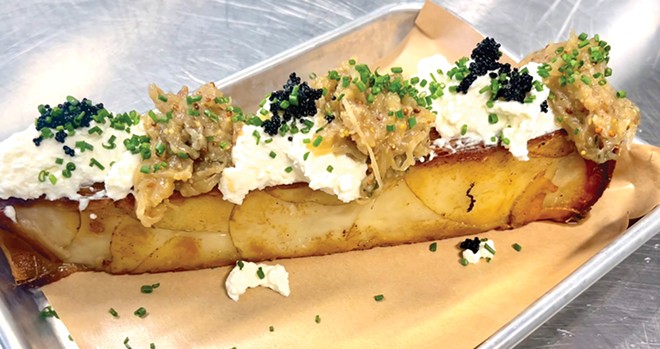
The origin story of the potato goes back 7,000-10,000 years to the Andes mountain region of southern Peru and northwestern Bolivia. Spanish conquistadors encountered potatoes in Peru in 1536 and brought them back to Europe. Leave it to the gastronomic creativity of the French to transform this humble tuber into a decadent and delicious dish known as le pavé de pommes de terre or potato pavé.
A potato pavé is an elegant dish that's a more elaborate version of scalloped potatoes. Pavé is a French word meaning "paving stones." A potato pavé is made with thinly sliced potatoes cooked in butter and cream and then layered in a baking pan, cooled, weighted down, refrigerated, unmolded, trimmed into smaller portions and sautéed on the cut sides until golden brown. A pavé is soft and creamy on the inside and crispy and crunchy on the exterior. A potato pavé tastes great on its own or served as a side dish with any meat main course. When I worked at Minneapolis' Spoon and Stable restaurant, we served a potato pavé alongside a dry-aged ribeye, sauced with a black truffle vinaigrette. At Caprae, Prairie Fruits Farm and Creamery's farm-to-table restaurant in Champaign, we offer a potato pavé on our Sunday brunch menu, topped with caramelized onions, our own fresh goat cheese, chives and tobiko caviar.
Though it is somewhat labor intensive, much of the time is hands-off. I recommend starting the dish the day before you intend to serve it. Slice, bake, cool, weigh down the potatoes and store in the refrigerator until you are ready to serve. Then, brown each portion of potato pavé on the stovetop just before serving. The potato can be served hot or at room temperature.
A potato pavé should be made with a starchy potato, such as a russet or Idaho, because they bake well, are dry and hold their shape. Waxy potatoes such as Yukon Golds should be avoided because they contain less starch and you will need the starch to help the potato layers stick together. The potatoes shouldn't be soaked in water ahead of time; soaking will cause them to lose some of their starch, which also helps to keep the dish creamy.
It is important to slice the potatoes very thinly, about 1/16 of an inch. In restaurant kitchens, this is commonly done on a commercial meat slicer. In home kitchens, it's best to use an adjustable slicer known as a mandoline. I like using a Japanese Benriner mandoline, which sells for about $40. It can slice potatoes up to 2 1/2 inches wide. If your potato is wider, you'll need to trim the sides to fit. A word of caution: Mandolines are notorious for slicing fingers. Be extremely careful when using one or invest in a pair of cut-resistant food-grade gloves. They sell for around $10.
Potato pavé
This impressive layered potatoes-and-cream preparation makes an elegant brunch dish or side dish for dinner.
Serves: 4 side dishes or 8 appetizers
Ingredients:
1 cup heavy cream
4 tablespoons unsalted butter, plus more for greasing pan (softened)
Kosher salt and freshly ground black pepper
3 pounds russet or Idaho potatoes
Avocado, grapeseed or rice bran oil
2 fresh thyme sprigs for both frying and garnish
2 cloves garlic, skin left on and smashed
Minced fresh chives
Equipment needed:
8-inch by 8-inch baking pan
Mandoline slicer
Preparation:
Before you begin, cut a piece of cardboard slightly smaller than the top of an 8-inch by 8-inch baking pan so that it will cover the top of the pavé without resting on the sides of the pan. Wrap the cardboard with aluminum foil.
Preheat oven to 350 degrees.
Pour cream and 4 tablespoons of butter into a large saucepan and season with 1 teaspoon salt and 1/2 teaspoon pepper. Warm the mixture over medium heat until the butter melts. Reduce heat to low to keep the mixture warm.
Peel the potatoes. With a knife, cut a thin lengthwise slice off one side of a potato so it will rest flat on the mandoline. Carefully slice the potatoes lengthwise into 1/16-inch slices, adding the slices to the cream/butter as you go. Toss the potato slices in the mixture occasionally to keep them from oxidizing. Repeat the process with the remaining potatoes.
Grease the 8-inch by 8-inch baking pan with some softened butter. Line the pan with parchment paper, leaving a 4-inch overhang on the sides. The overhangs will be cover for the potatoes as they cook and later will help remove the pavé from the baking pan. Brush the parchment paper with additional softened butter.
Place the slices in an even layer at the bottom of the pan; repeat the process to form a second layer. Press each layer down firmly to eliminate air pockets. Continue layering potatoes until the pan is filled.
Fold the sides of parchment paper over the potatoes. Cover the pan tightly with aluminum foil. This will allow the potatoes to steam as they bake. Transfer to the oven.
Bake until potatoes are completely tender when pierced with the tip of a sharp knife, about 1 hour and 45 minutes. If you have a kitchen thermometer, bake until the internal temperature reaches 180 degrees. Remove from the oven and cool for 15 minutes.
Place the foil-wrapped cardboard over the parchment-covered potatoes and press firmly down. Place some heavy cans or other weights on top of the cardboard. Refrigerate for at least six hours or up to two days.
The next day, remove the weights and run an offset spatula between the parchment paper and pan to release. Lift the ends of the parchment to free the pavé from the pan and invert it onto a cutting board.
Trim a small slice from the four sides of the pavé and cut into eight equal pieces.
Let the pavé cool to room temperature for at least 30 minutes or refrigerate if preparing ahead.
Heat a large skillet over medium-high heat. Generously coat the pan with oil and add the thyme sprigs and garlic. When the oil is hot, add the pavé sections, with the cut side down. Remove the thyme or garlic before they burn; they are only used to flavor the oil. Sauté, basting with the oil, until golden brown and crispy, then turn and brown on the opposite side.
Plate the pavé pieces browned side up. Sprinkle with chives. Serve hot or at room temperature.



